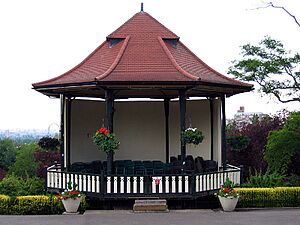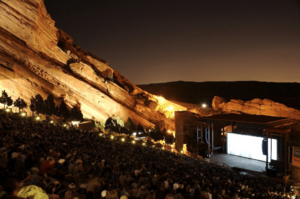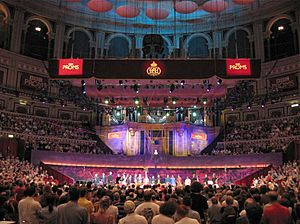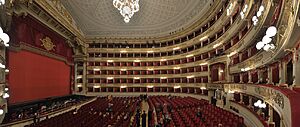Music venue facts for kids
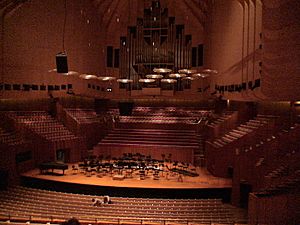
A music venue is a place where people go to enjoy live music or performances. These places come in all shapes and sizes. They can be small coffeehouses for folk music or huge sports stadiums. You might also find them as outdoor bandshells or grand concert halls.
Different types of music venues often host different kinds of music. For example, opera houses and concert halls are usually for classical music. On the other hand, public houses (pubs) and nightclubs often play modern music. This includes rock, dance, country, and pop.

Music venues can be funded by private owners or by the government. Some venues charge money to get in, while others are free. A bandstand in a park, for instance, is usually free and funded by the city. A nightclub, however, is a private business. It usually charges an entry fee to make money. Not all music venues have live performers. Some places, like discothèques, have disc jockeys who play recorded music.
The type of venue can affect many things. This includes when it's open and how long performances last. It also changes the sound technology used. Some venues offer other fun things to do. You might find performance art, standup comedy, or social activities. For example, at a bar or pub, a house band might play live songs. Between songs, recorded music might be played. Some venues play live music softly in the background. This could be a grand piano in a restaurant.
What Makes Music Venues Different?
Music venues can be grouped in many ways. The type of music played often decides many other things. Also, whether the venue is temporary or who owns it matters.
Permanent or Temporary Places
Most music venues are permanent buildings. But some are temporary, meaning they are built just for a short time. An example of a temporary venue is one built for a music festival.
Who Owns the Venue?
Music venues are usually private businesses. They can also be public places set up by a city or government. Some venues are run by groups that are not part of the government. These might be music associations.
Music Styles Played
Some venues only host shows of one specific music style. Opera houses, for instance, are mainly for opera. Stadiums, however, might host rock, classical, or world music concerts.
Size and How Many People Fit
Music venues can be sorted by their size and how many people they can hold. The smallest places, like coffeeshops, can fit only a few dozen people. The largest venues, such as stadiums, can hold tens of thousands of fans.
Indoor or Outdoor Venues
Music venues can be either outdoors or indoors. Outdoor venues include bandstands and bandshells. These often offer little shelter for musicians. They are usually found in parks. A temporary music festival is typically an outdoor event. Indoor venues include public houses, nightclubs, coffee bars, and stadiums.
Live or Recorded Music
Venues can play live music, recorded music, or both. This depends on the event or time of day. Discothèques are mostly for recorded music played by a disc jockey. Live music venues have one or more stages for performers.
Getting In and Opening Times
Some venues don't require tickets. You can just pay a small fee at the door. Others require you to buy tickets in advance.
How Important is the Performance?
At some venues, the main reason to be there is to watch the show. This is true for opera houses or classical music halls. In other places that also serve food, the music might be playing softly. It adds to the atmosphere while people eat and talk.
Types of Music Venues
Amphitheater
Amphitheaters are usually round or oval-shaped and open to the sky. They often have seats arranged in tiers, like steps.
Bandshell and Bandstand
A bandshell is a large outdoor stage. It is often used by concert bands and orchestras. The roof and back of the shell protect musicians. They also help the sound travel out to the audience. A bandstand is a smaller outdoor structure.
Concert Hall
A concert hall is a special place built for instrumental classical music. A concert hall might be part of a bigger performing arts center.
Jazz Club
Jazz clubs are venues made for a specific type of music: jazz. They are places where you can hear live jazz music. Jazz clubs are usually a type of nightclub or bar. In the past, jazz clubs were large rooms. This was when jazz bands were big and people danced. Later, jazz became more about listening. So, smaller clubs with small stages became common.
Today, jazz clubs can be found in many places. They might be in basements, old shops, or on upper floors of buildings. They are often smaller than rock music clubs. This creates a cozy atmosphere for jazz shows. Some jazz clubs have a small fee to enter if a live band is playing. Many clubs also host "jam sessions." This is where both professional and amateur musicians can play together.
Live House
In Japan, small live music clubs are called live houses (ライブハウス). They often feature rock, jazz, blues, and folk music. These venues have been around since the 1970s. The oldest live house is Coffee House Jittoku in Kyoto, founded in 1973. The idea then spread across Japan. In recent years, similar places have appeared in big cities in South Korea, Taiwan, and China. Many of them are also called "live houses."
Opera House
An opera house is a theater built especially for opera performances. It has a stage, an orchestra pit, and seats for the audience. It also has backstage areas for costumes and sets. Some opera houses are part of larger performing arts centers. The term opera house is often used for any large performing arts center.
The Teatro San Carlo in Naples, opened in 1737, was very important. It introduced the horseshoe-shaped auditorium. This design became a model for many other theaters in Italy and Europe. Opera was very popular in Europe in the 18th and 19th centuries. So, opera houses are usually large, often holding over 1,000 people. Many major opera houses built in the 19th century had between 1,500 and 3,000 seats. Examples include Paris' Palais Garnier (2,200 seats) and the Royal Opera House in London (2,268 seats). Modern opera houses, like the Metropolitan Opera House in New York, are even larger, with about 3,800 seats.
In a traditional opera house, the audience area is U-shaped. Around this are levels of balconies and special "boxes." Since the late 1800s, opera houses often have an orchestra pit. This is where musicians sit below the audience level. This helps their music blend with the singers' voices without being too loud. An opera orchestra can be very large, sometimes over 100 players. An opera can also have many singers, a chorus, and dancers. So, a major opera house needs many dressing rooms. They often have shops to build sets and costumes. They also have places to store costumes, makeup, and props.
Big opera houses often have very advanced stages. They use large stage elevators to change heavy sets quickly. At the Metropolitan Opera, sets can even change while the audience watches. Singers might rise or descend as they sing. This happens in their productions of operas like Aida. The Royal Opera House in London was updated in the late 1990s. It kept its old auditorium but added new backstage areas.
Opera houses use the latest technology for lighting and stage effects. However, traditional opera houses usually do not use microphones to make singers louder. Trained opera singers can project their voices well enough. But since the 1990s, some opera houses have started using subtle sound systems. These systems quietly improve the sound.
Public Houses and Nightclubs
A pub, or public house, is a place where people gather. It is a social place and an important part of British, Irish, and Australian cultures. Most pubs offer different kinds of drinks and often serve meals and snacks. Pubs can also be places for live music. In the 1970s, pubs became important for bands. This led to a music style called pub rock.
A nightclub is an entertainment place that usually stays open late. Nightclubs are different from regular bars. They often have a stage for live music and one or more dance floors. They also have a DJ booth where a DJ plays recorded music. Some nightclubs have special VIP areas for famous people. Nightclubs often have staff at the door to check who comes in. They might not let people in with very casual clothes. The busiest nights for nightclubs are Friday and Saturday. Most clubs focus on certain music genres, like house music or hip hop.
Stadiums and Arenas
A stadium is a large place for outdoor sports, concerts, or other events. It has a field or stage surrounded by seats for spectators. In the 1960s, stadiums started being used for popular music concerts. This led to the term "stadium rock." This style of music often included hard rock and progressive rock. The idea of stadium rock really took off when The Beatles played Shea Stadium in New York in 1965.
Later in the 1960s, bands like The Rolling Stones and Led Zeppelin used large stadiums for their tours. In the mid-1970s, sound systems became more powerful. This allowed even bigger venues to be used. Smoke, fireworks, and fancy lighting shows became common at these concerts. Famous bands from this time included Journey, Queen, and Kiss. Since the 1980s, many stars like Madonna, Beyoncé, and Taylor Swift have done huge stadium concert tours.
Theater
A theater or playhouse is a building where theatrical works or plays are performed. Other shows, like musical concerts, can also happen there. A theater built for opera is called an opera house. The theater helps define the spaces for performers and the audience. It also has areas to support the performers, technical crew, and audience. There are many types of theaters. Some are built for specific shows, while others are more general. They can range from open-air amphitheaters to grand, cathedral-like buildings. Some theaters have a fixed performing area, called the stage. Others, like "black box theaters," might not. For the audience, theaters can have balconies, special "boxes," and "house seats" which offer the best view.
See also
- Art space
- Auditorium
- Concert hall
- Cultural centre
- History of music
- Music festival
- Music gym
- Music venues in the Netherlands
- List of concert venues


